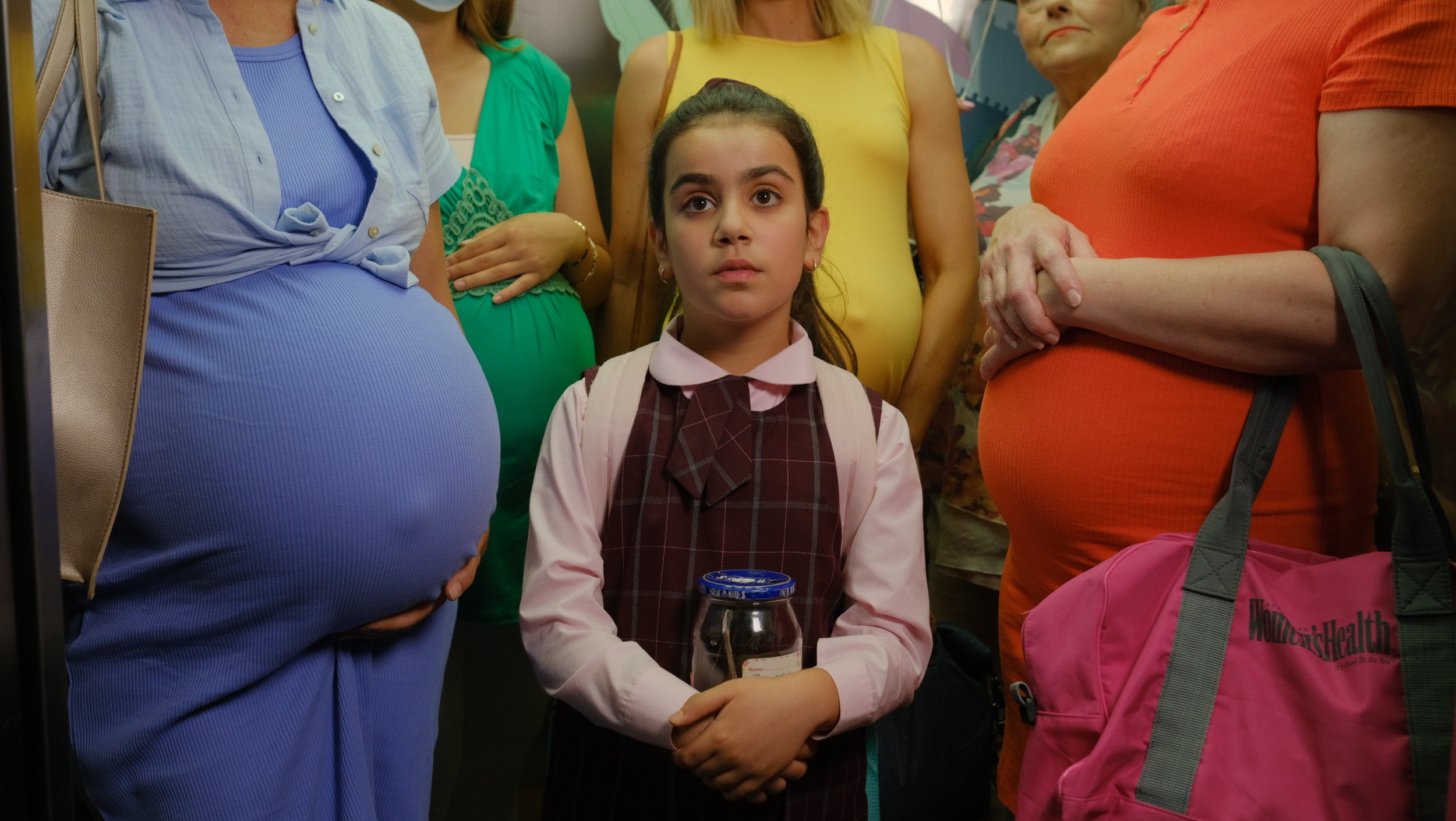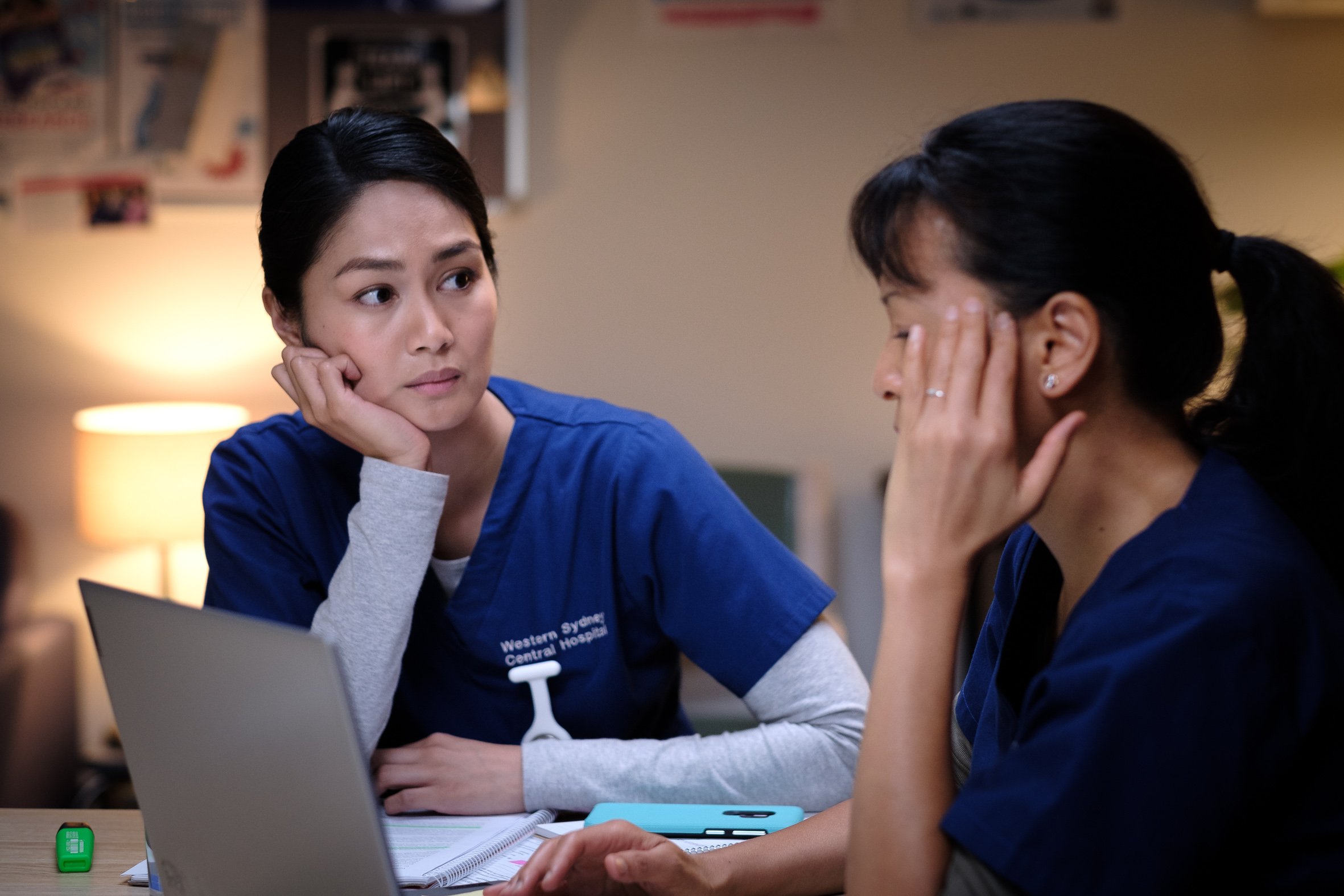HERE OUT WEST - An Honest Review
Still from ‘We, the Spiders’ written by Nisrine Amine (Image credit: Tania Lambert).
At a local hospital’s newborn ward, a grandmother carries her newborn grandchild in her arms, her eyes filled with adornment and hope. As she cradles the baby, her neighbour — a bored, but sassy-mouthed Lebanese school girl — watches through the glass display with her pet spider, kept in a crudely labelled jar. In the quiet, familial bonding, the grandmother prays under her breath - ‘God, grant me the serenity to accept the things I cannot change, the courage to change the things I can, and the wisdom to know the difference…’
In the blink of an eye, she dashes out of the ward with her grandchild. She pulls the school girl with her, and leaves the scene, causing a ripple that starts a chain of events across Western Sydney.
Here Out West is a milestone in Western Sydney cinema. Supported by Co-Curious, ABC, and Screen Australia, the anthology film features stories from eight emerging writers from the area to present the ‘buzzing and ever-changing melting pot’ of Western Sydney. From feuding brothers, and bonds between Bengali-speaking diasporas, to Filipino nurses, Vietnamese lawyers, and Chinese restaurants - each writer illustrates one part of Western Sydney’s cultural mosaic, resulting in a colourful portraiture exploring cultural identity, belonging, and self-growth.
The film took the spotlight at Sydney Film Festival late last year, opening the prestigious event at the State Theatre alongside two other screenings across Sydney. All three festival screenings sold tickets in less than a week. Although Western Sydney remains severely overlooked and under-represented in the public eye, it’s clear that there’s an audience and demographic for Western Sydney storytelling. However, with the film’s release date just around the corner, it’s imperative to talk about what to expect for us film lovers across Sydney; be it casual cinemagoers and Netflix fanatics, or seasoned cinephiles and Criterion baddies.
Thus, I arrive here to settle the age-old question: is Here Out West worth watching?
Still from ‘The Eternal Dance’ written by Bina Bhattacharya (Image Credit: John Platt).
As the first of its kind, Here Out West rightfully depicts the diverse mosaic of cultures across the suburbs, each segment featuring at least one non-English native language. This includes the Chilean soccer-playing guard, Jorge, in ‘Everything Changes,’ the Kurdish family of refugees in ‘The Musician,’ and the Cantonese-speaking restaurant owners in ‘Closing Night.’ The film’s communal model of filmmaking is not new, at least within the context of Austronesian cinema - the collaborative approach, in fact, echoes that of New Zealand productions Waru and Vai, both films sharing a similar support for emerging writers. This approach not only promotes a community inflective practice of filmmaking, but also helps inform Here Out West’s broader themes of connection and care.
Stitching various backgrounds together thus presents numerous character and narrative beats that are unique to each writer’s culture. Bina Bhattacharya’s segment, ‘The Eternal Dance,’ explores the conditions of living as a mixed-race woman through Ashmita (Leah Vandenberg), who is unable to understand her dying father’s last words. After following Robi (Arka Das) from the previous segment ‘Brotherhood,’ she asks him to take on the task of translating her father’s Bengali. Through the undying power of language, Das and Bhattacharya’s characters share a deeply felt experience of homecoming, as we watch one character rekindle and reconnect with their mother tongue through the other’s native tongue. ‘The Long Shift,’ is another example, written by Filipino writer Vonne Patiag (who also makes a blink-and-you-miss surprise cameo!). Directed by renowned Indigenous filmmaker Leah Purcell, we follow nurse Roxanne (Christine Milo) who takes up the enduring task of covering a second shift in the hospital’s emergency ward. A love letter to Filipina frontline nurses, Patiag’s segment presents the significance of family values for every hard-working Filipino; be it the sisterhood of Filipina nurses who tsismis in break rooms, or distant relatives from the Philippine homeland.
Still from ‘The Long Shift’ written by Vonne Patiag (Image credit: John Platt).
However, as much as I praise Here Out West’s model of communal filmmaking, it’s equally valid to be critical and examine this film for what it is. Although Here Out West promises the so-called ‘melting pot’ of cultural identities, the film, at its very core, presents a singular, homogenised image of Western Sydney. Much of the scenery and writing is undoubtedly emblematic of what we call ‘the area’ - there’s even a cheeky line about PCYC that may stifle giggles from audience members. However, amidst the car parks and suburban front yards, not one character speaks about hailing from Doonside or Campbelltown. Is ‘Western Sydney Central Hospital’ located in Westmead or Blacktown? What street in Bankstown or Liverpool does Tuan drive through? While, on one hand, it elevates the universalising experiences of growing up in Western Sydney, the removed locality, on the other hand, dodges that opportunity for viewers to identify with a specific pocket of Western Sydney. Having pride or repping the area can be as simple as feeling grateful for El Jannah dates outside Westpoint, or finding solace and comfort at Mount Druitt’s Starbucks.
A second concern worth raising is that of representation and realism. As suburban underdogs, many of us can relate to the struggle of breaking stigmas and stereotypes surrounding the suburbs. Western Sydney is especially stigmatised by its complex social issues and criminal activities, including street violence (‘postcode wars’), drug abuse, poverty, and home break-ins. Making a movie about Western Sydney without acknowledging these realities is almost akin to shooting Hong Kong’s neon jungle in Fallen Angels, without the gritty colour-grading or wide-angle lenses. This is not to accuse the writers or producers for being insular or tone deaf. If anything, it’s worth commending the authentic perspectives and level of personal inflection embedded in a work solely focused on cultural diversity. However, my criticism aims to address the importance of illustrating a nuanced, complicated and therefore brutally honest portrayal of Western Sydney for future filmmakers. It’s one thing to break the stigma and stereotypes, but it’s another to romanticise a working-class reality.
With that, this then leads us to the question of audience appeal. For us Western Sydney baddies, Here Out West is a definite win for representation - but what does it mean for those who do not identify with Western Sydney, or aren’t local to the area? The film’s success seems to be dependent on two different target audiences: Western Sydney locals, and those aware of the stigmas and bad rep surrounding Western Sydney. The title itself, Here Out West, primes us for this experience. Its repeated thesis on community bonding and multicultural identity is inherently tethered to socio-political context and, broadly speaking, the notion that there is more to Western Sydney beyond the harmful preconceptions.
Although Here Out West is marketed as a groundbreaking game-changer for Western Sydney stories - a film for the area, by the area - it’s inevitable for a film critic or non-local viewer to assess this film separately from its context and aims. Despite the film’s definitive target audience, there will also be outsiders who remain oblivious to the area’s complicated reputation and toxic stigmas. Outside its celebrated themes of family and cultural identity, what message does Here Out West leave for those unfamiliar with Western Sydney? Is it imperative for outsiders to be informed about the area and the film’s production history to fully appreciate the work? Or is it unfair to assess this anthology without understanding Western Sydney’s struggle for positive media coverage? What does this ‘buzzing and ever-changing melting pot’ do to inform those from Crows Nest or Surry Hills about Western Sydney? Does it seek to entertain, educate, or both?
As fruitful as it would be to continuously scrutinise this film, I must return to my original question: whether or not Here Out West is worth watching. As mentioned, the anthology film is the first of its kind to emerge out of Western Sydney cinema. For a film that supports emerging writers from the area, it’s worth buying that movie ticket at your local Hoyts or Event Cinemas to experience the magic of local storytelling. Here Out West is, at its core, a film for the community, by the community. As for more seasoned cinephiles, don’t expect a twisted, monumental, SBS-after-nine-o’clock arthouse piece that’d leave Tarkovsky rolling in his grave. This film adopts an accessible, conventional style and approach to its creative direction and cinematography, to help elevate the diverse and cultural narratives on show. For that, we cannot expect these emerging young writers to become the next Paul Thomas Anderson or Wong Kar-wai overnight.
At the end of the day, Here Out West builds a foundation for future filmmakers and storytellers to improve upon. While imperfect, these stories are told with so much heart, passion, and authenticity. I wish all the best for these promising writers in their careers - may the future of Western Sydney cinema continue paving the way for newer, fresher voices.
Here Out West - coming to a theatre near you! (Image credit: Emerald Productions)
Here Out West will release in Australian cinemas nationally this coming Thursday on February 3, 2022 and on ABC later this year.




